Abstract
A failure of the usual increase in plasma adrenaline and noradrenaline concentrations during submaximal exercise has been suggested as a contributory cause of exercise induced asthma. Six normal subjects and six asthmatic patients underwent a standard graded maximal exercise test. Measurements of oxygen consumption, minute ventilation, exercise time, blood lactate concentration, and heart rate indicated that the two groups achieved similarly high work loads during exercise. Mean FEV1 fell by 20% in asthmatic patients after exercise. Basal plasma adrenaline concentrations (nmol/l) increased in normal subjects from 0.05 to 2.7 and in asthmatic patients from 0.12 to 1.6 at peak exercise. Noradrenaline concentrations (nmol/l) increased in normal subjects from 2.0 to 14.3 and in asthmatic patients from 1.9 to 13.7 at peak exercise. The increases in adrenaline and noradrenaline in the asthmatic patients did not differ significantly from the increases in normal subjects. Thus a reduced sympathoadrenal response to exercise seems unlikely to be an important mechanism in the pathogenesis of exercise induced asthma.
Full text
PDF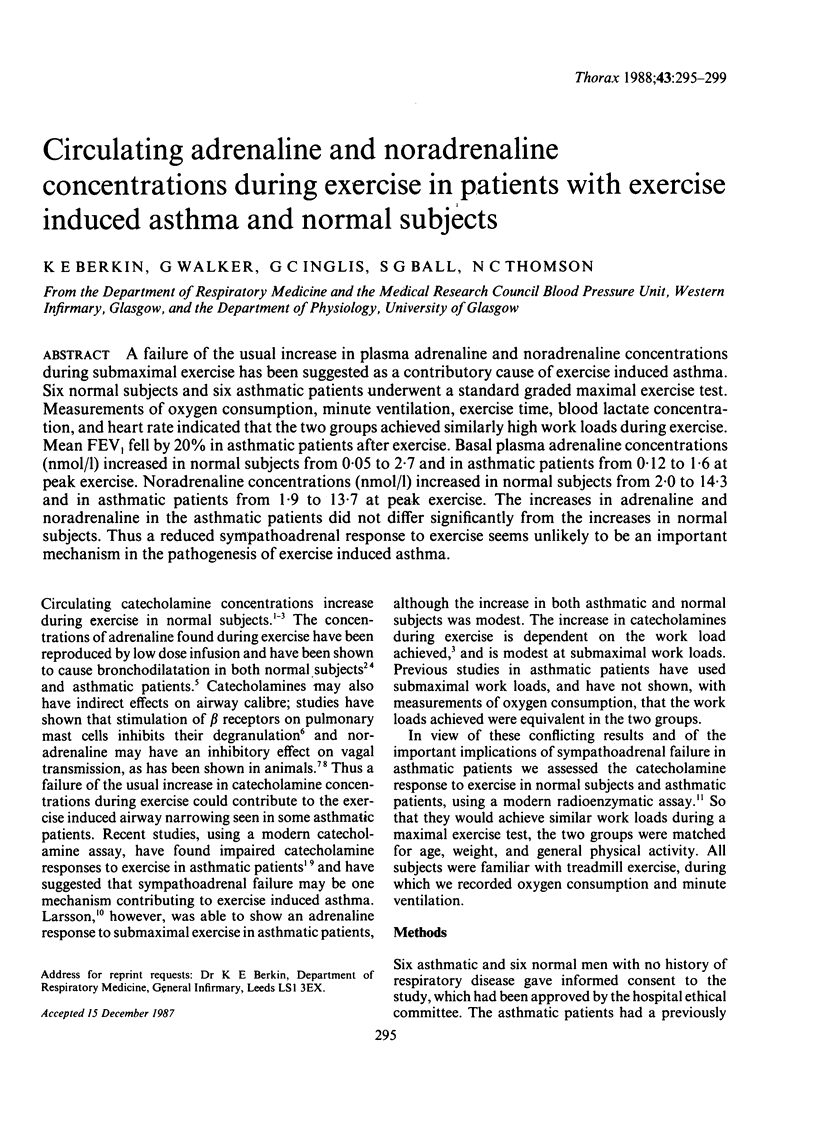
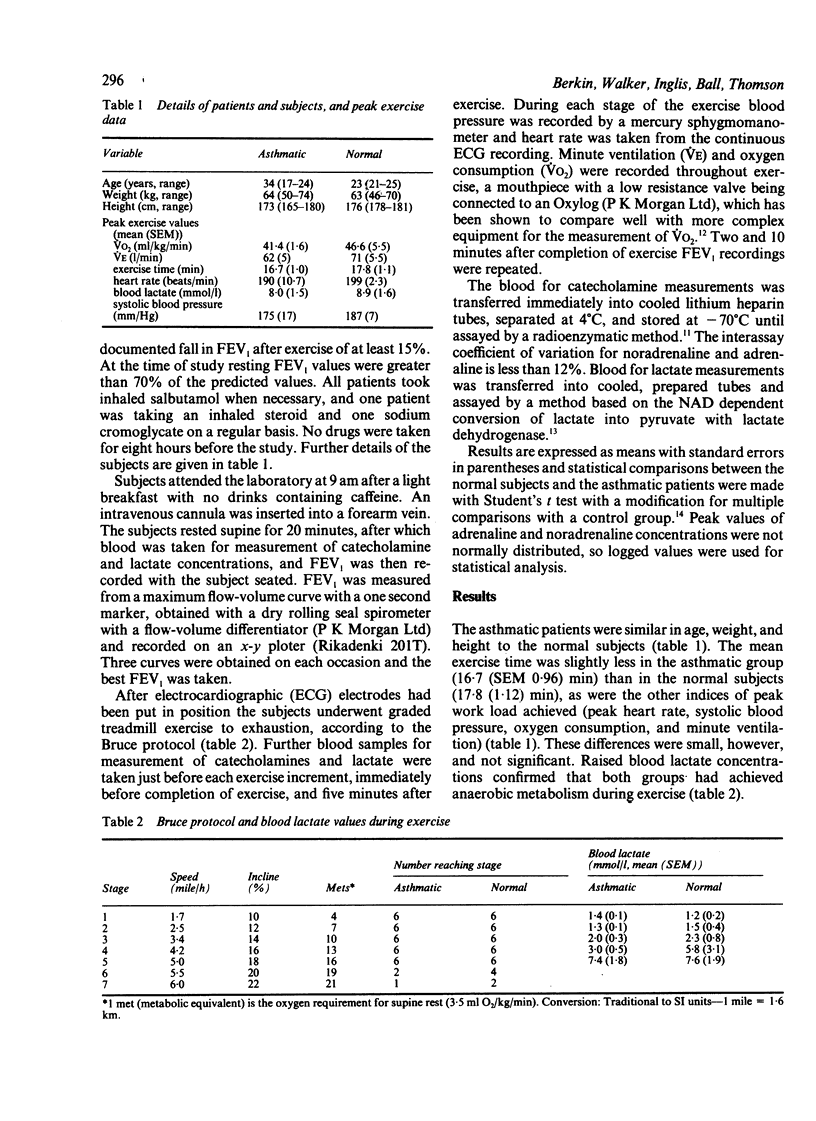
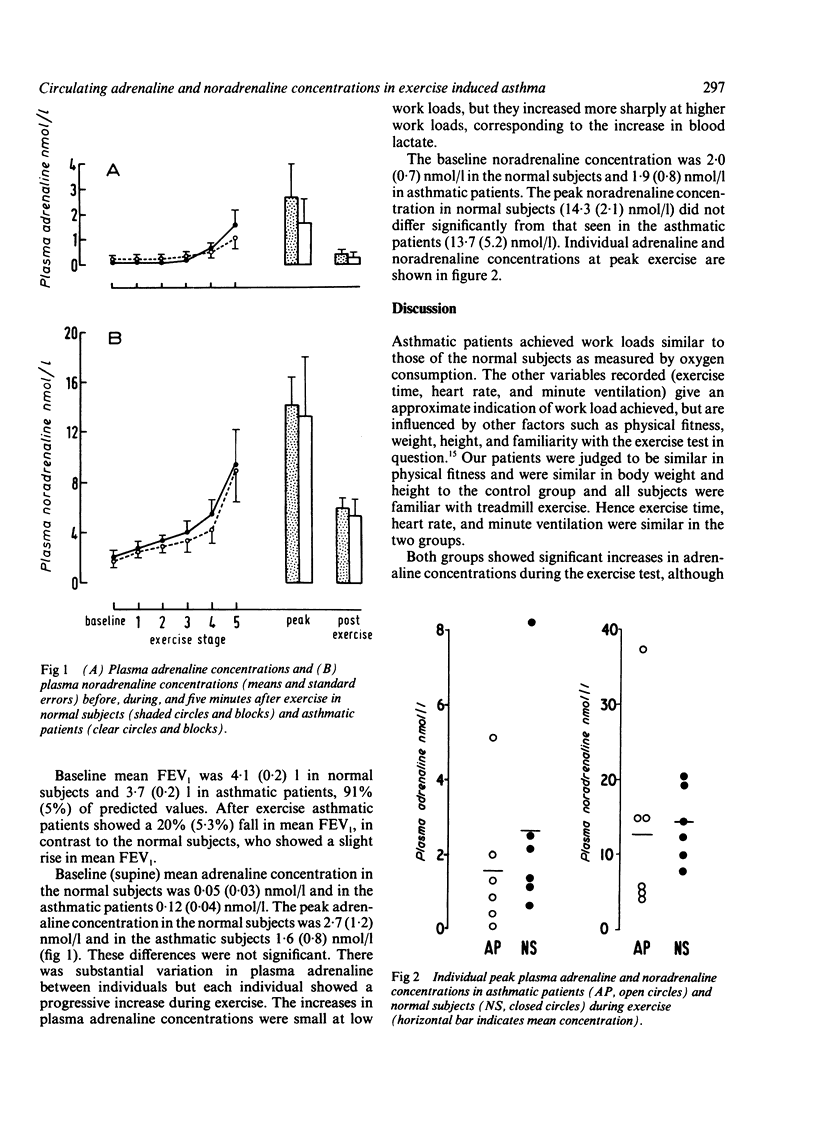
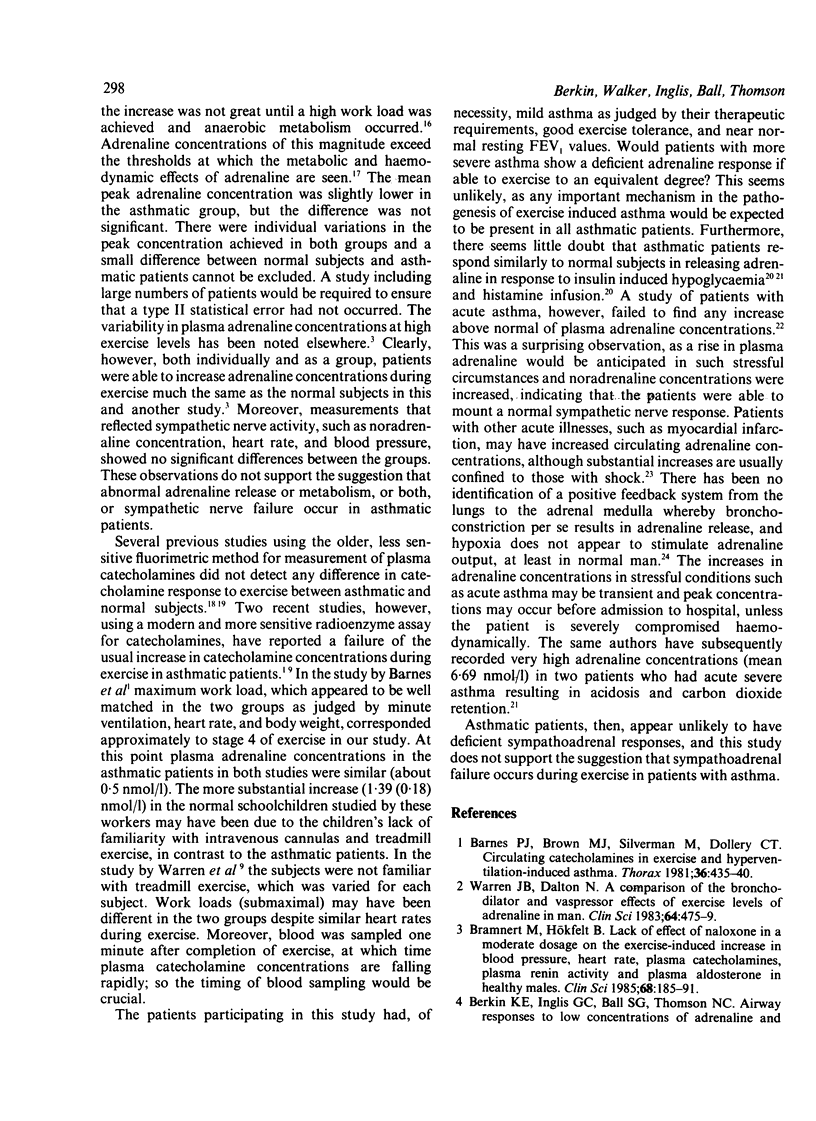
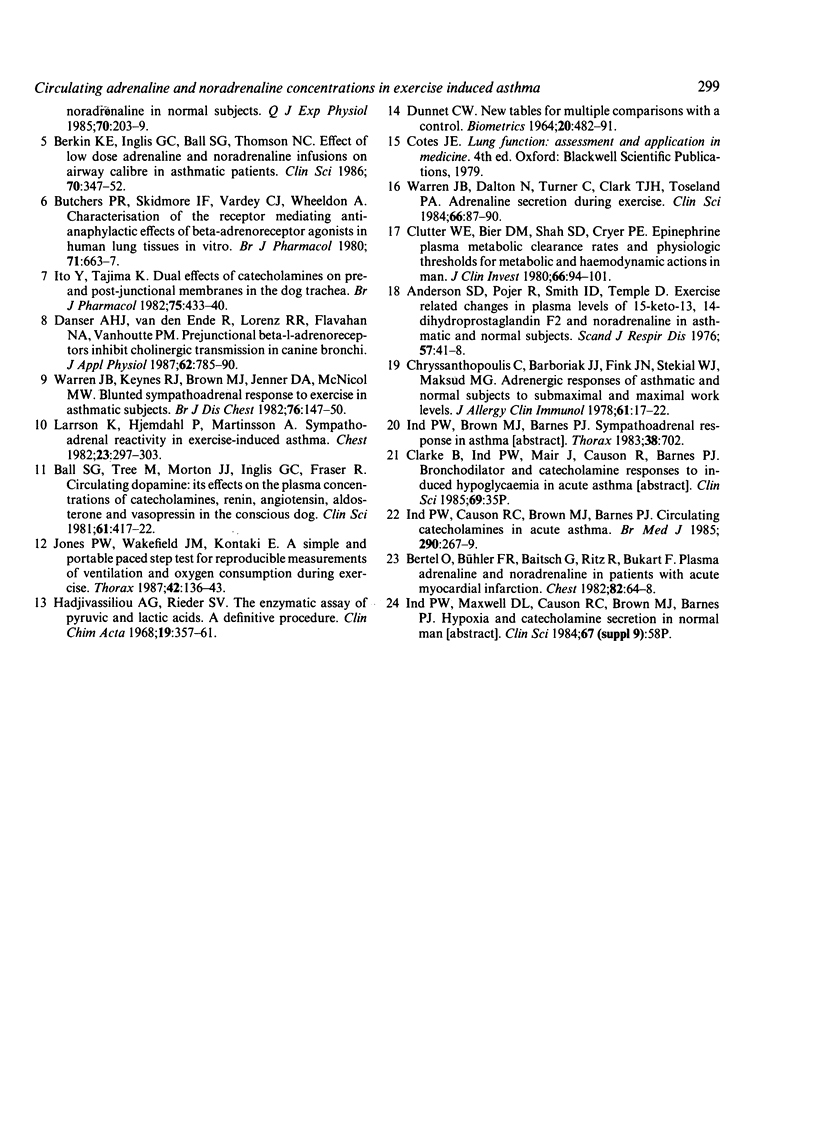
Selected References
These references are in PubMed. This may not be the complete list of references from this article.
- Anderson S. D., Pojer R., Smith I. D., Temple D. Exercise-related changes in plasma levels of 15-keto-13,14-dihydro-prostaglandin F2alpha and noradrenaline in asthmatic and normal subjects. Scand J Respir Dis. 1976;57(1):41–48. [PubMed] [Google Scholar]
- Ball S. G., Tree M., Morton J. J., Inglis G. C., Fraser R. Circulating dopamine: its effect on the plasma concentrations of catecholamines, renin, angiotensin, aldosterone and vasopressin in the conscious dog. Clin Sci (Lond) 1981 Oct;61(4):417–422. doi: 10.1042/cs0610417. [DOI] [PubMed] [Google Scholar]
- Berkin K. E., Inglis G. C., Ball S. G., Thomson N. C. Airway responses to low concentrations of adrenaline and noradrenaline in normal subjects. Q J Exp Physiol. 1985 Apr;70(2):203–209. doi: 10.1113/expphysiol.1985.sp002903. [DOI] [PubMed] [Google Scholar]
- Berkin K. E., Inglis G. C., Ball S. G., Thomson N. C. Effect of low dose adrenaline and noradrenaline infusions on airway calibre in asthmatic patients. Clin Sci (Lond) 1986 Apr;70(4):347–352. doi: 10.1042/cs0700347. [DOI] [PubMed] [Google Scholar]
- Bertel O., Bühler F. R., Baitsch G., Ritz R., Burkart F. Plasma adrenaline and noradrenaline in patients with acute myocardial infarction. Relationship to ventricular arrhythmias of varying severity. Chest. 1982 Jul;82(1):64–68. doi: 10.1378/chest.82.1.64. [DOI] [PubMed] [Google Scholar]
- Bramnert M., Hökfelt B. Lack of effect of naloxone in a moderate dosage on the exercise-induced increase in blood pressure, heart rate, plasma catecholamines, plasma renin activity and plasma aldosterone in healthy males. Clin Sci (Lond) 1985 Feb;68(2):185–191. doi: 10.1042/cs0680185. [DOI] [PubMed] [Google Scholar]
- Butchers P. R., Skidmore I. F., Vardey C. J., Wheeldon A. Characterization of the receptor mediating the antianaphylactic effects of beta-adrenoceptor agonists in human lung tissue in vitro. Br J Pharmacol. 1980;71(2):663–667. doi: 10.1111/j.1476-5381.1980.tb10987.x. [DOI] [PMC free article] [PubMed] [Google Scholar]
- Chyrssanthopoulos C., Barboriak J. J., Fink J. N., Stekiel W. J., Maksud M. G. Adrenergic responses of asthmatic and normal subjects to submaximal and maximal work levels. J Allergy Clin Immunol. 1978 Jan;61(1):17–22. doi: 10.1016/0091-6749(78)90468-2. [DOI] [PubMed] [Google Scholar]
- Clutter W. E., Bier D. M., Shah S. D., Cryer P. E. Epinephrine plasma metabolic clearance rates and physiologic thresholds for metabolic and hemodynamic actions in man. J Clin Invest. 1980 Jul;66(1):94–101. doi: 10.1172/JCI109840. [DOI] [PMC free article] [PubMed] [Google Scholar]
- Danser A. H., van den Ende R., Lorenz R. R., Flavahan N. A., Vanhoutte P. M. Prejunctional beta 1-adrenoceptors inhibit cholinergic transmission in canine bronchi. J Appl Physiol (1985) 1987 Feb;62(2):785–790. doi: 10.1152/jappl.1987.62.2.785. [DOI] [PubMed] [Google Scholar]
- Hadjivassiliou A. G., Rieder S. V. The enzymatic assay of pyruvic and lactic acids. A definitive procedure. Clin Chim Acta. 1968 Mar;19(3):357–361. doi: 10.1016/0009-8981(68)90258-1. [DOI] [PubMed] [Google Scholar]
- Ind P. W., Causon R. C., Brown M. J., Barnes P. J. Circulating catecholamines in acute asthma. Br Med J (Clin Res Ed) 1985 Jan 26;290(6464):267–269. doi: 10.1136/bmj.290.6464.267. [DOI] [PMC free article] [PubMed] [Google Scholar]
- Ito Y., Tajima K. Dual effects of catecholamines on pre- and post-junctional membranes in the dog trachea. Br J Pharmacol. 1982 Mar;75(3):433–440. doi: 10.1111/j.1476-5381.1982.tb09158.x. [DOI] [PMC free article] [PubMed] [Google Scholar]
- Jones P. W., Wakefield J. M., Kontaki E. A simple and portable paced step test for reproducible measurements of ventilation and oxygen consumption during exercise. Thorax. 1987 Feb;42(2):136–143. doi: 10.1136/thx.42.2.136. [DOI] [PMC free article] [PubMed] [Google Scholar]
- Warren J. B., Dalton N. A comparison of the bronchodilator and vasopressor effects of exercise levels of adrenaline in man. Clin Sci (Lond) 1983 May;64(5):475–479. doi: 10.1042/cs0640475. [DOI] [PubMed] [Google Scholar]
- Warren J. B., Dalton N., Turner C., Clark T. J., Toseland P. A. Adrenaline secretion during exercise. Clin Sci (Lond) 1984 Jan;66(1):87–90. doi: 10.1042/cs0660087. [DOI] [PubMed] [Google Scholar]
- Warren J. B., Keynes R. J., Brown M. J., Jenner D. A., McNicol M. W. Blunted sympathoadrenal response to exercise in asthmatic subjects. Br J Dis Chest. 1982 Apr;76(2):147–150. [PubMed] [Google Scholar]


